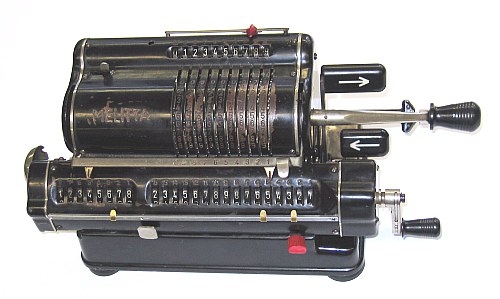The LOWER DECIMAL SLIDER & MARKERS and the BACK-TRANSFER CAP are home made
T E C H N I C A L D A T A of the Mechanical Calculator MELITTA
**************************************************************************
Model » IV/16 «
Serial Number: 73209
Dimensions: (ca.) Width = 12 " / 30 cm
Depth = 5_1/4" / 13 cm
Height = 5_1/4" / 13 cm
Weight: (ca.) 9 lb / 4 kg
Mechanics: Pin-Wheel / Sprossenrad
10s Carry Mechanism
Functions: Add, Subtract, Multiply, Divide
Back-Transfer / Rueckuebertragung
Registers: Input = 10 Decimals
Counter = 8 Decimals
Arithmetic = 16 Decimals
Manufacturer:
FORTUNA-WERK VEB
Suhl / Thueringen
Germany
1955
H O W T O U S E the MELITTA IV/16
*****************************************
BASIC SETTINGS:
===============
(a) Crank:
----------
For addition (+) the crank is turned clockwise; for subtraction (-) the
crank is turned counter-clockwise. In the idle position the crank is DOWN
& LOCKED. To make one or more turns with the crank, pull out the handle to
unlock. When finished the turn(s), let the handle snap into lock again. The
locked down position only makes other functions (ex. clearing) accessible.
REMARK: Every started turn has to be finished completely!
Accidentally started turns are correctible somehow.
(b) Shifting the Carriage:
--------------------------
With the ARROW KEYS the carriage will move one step to the LEFT or RIGHT.
Pushing the LEFT BLACK KNOB on front allow the carriage to be moved by hand
continuously right or left.
The left position "1" is the "Start Position" of the carriage.
(c) Clear Input:
----------------
Moving the SILVER HORIZONTAL LEVER up will reset the input to 0000000000.
(d) Clear Counter and Arithmetic Units:
---------------------------------------
Unusual: CLEARING needs TWO(2)TURNS of the carriage's crank. Moving the
build-in lever in the crank's shaft (= CLEAR-SELECT-LEVER ) allow 3 axial
positions: In the far left position only the counter unit will be cleared.
In the middle position counter & arithmetic units will be cleared. In the
far right position only the arithmetic unit will be cleared.
(e) Counting Direction:
-----------------------
After clearing, the (+/-) lever (on top, left) is in the middle
position. Depending of the first crank turn (clockwise or counter-
clockwise), the (+/-) lever will go either to (+) or (-). In case of (+)
the counter & arithmetic unit are working in the same direction; in case
of (-) both are working opposite. In both cases the counter is working
with 10s-carry - and allows "Shortened Method of Multiplication".
(f) Back Transfer:
------------------
For continuous multiplication the contents of the arithmetic unit
can be back transfered into the input register with this procedure:
Clear input unit. Set CLEAR-SELECT-LEVER to the right. Shift and hold
the RED LEVER under the arithmetic unit and turn the crank on the
carriage until the transfer is completed and the crank snaps in its rest.
Release the RED LEVER.
ADDITION & SUBTRACTION:
=======================
Example: 123 + 45 - 6 = 162
Clear input, counter and arithmetic units; set carriage to position 1.
ADD: Enter the first number (123) in the far right of the input unit.
Make a positive (clockwise) turn with the crank to transfer the number
into arithmetic unit. The counting unit displays the figure 1. Enter the
second number (45). Make a positive (clockwise) turn with the crank to
add the number. The arithmetic unit displays the intermediate sum (168)
and the counting unit displays the figure 2.
SUBTRACT: Enter the third number (6). Make a negative (counter-clockwise)
turn with the crank. The arithmetic unit displays the result (162) and
the counting unit is decreased by 1.
REMARK: NEGATIVE RESULTS are displayed in the arithmetic unit
as the COMPLEMENT of the next higher 10, 100, 1000, ...
Example: -12 = 99...9988
MULTIPLICATION:
===============
Example: 123 x 45 = 5535
Clear input, counter and arithmetic units.
Enter the multiplicand (123) in the far right of the input unit. The
multiplicator (45) has two digits, so the carriage is shifted to
position 2. Make positive (clockwise) turns with the crank, until the
first figure of the multiplicator (4) will appear in the 2nd position of
the counter unit. Shift the carriage to position 1. Repeat making positive
turns with the crank, until the second figure of the multiplicator (5)
appears in the 1st position of the counter unit. The multiplication is
done: The multiplicand (123) stays in the input unit, the multiplicator
(45) in the counter and the result (5535) is in the arithmetic unit.
DIVISION:
=========
Example: 22 : 7 = 3.1428571 Remainder 3
Division requires 3 steps:
(A) To Set the Divisor into Input Unit:
---------------------------------------
Clear arithmetic, counter & input units.
Enter the DIVISOR (7) in the far right of the input unit.
(B) To Set the Dividend into Arithmetic Unit:
---------------------------------------------
For the maximum number of decimals, pull out the carriage to the far
right. Set the DIVIDENT (22) into the arithmetic unit with the
affiliated toothed wheels appropriately under the divisor.
(C) To Divide:
--------------
Set the counting direction to (-). Make negative (counter-clockwise)
turns with the crank until the arithmetic unit shows an "underflow".
Make one positive (clockwise) turn with the crank. Move the carriage
to the next left position. Repeat this procedure until the required
number of decimals ...
The result (3.1428571) is in the counter unit, and the remainder (3)
is in the arithmetic unit. The divisor (7) stays in the input unit,
therefore an additional decimal can be estimated...
( 4, cause 4 x 7 = 28).
Have a look at "Calculating Trickies" ...
impressum:
**************************************************************************
© C.HAMANN http://public.beuth-hochschule.de/~hamann 02/01/08
|
